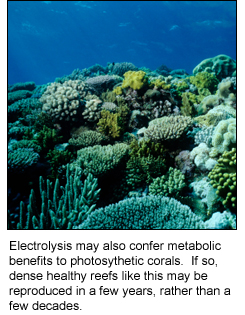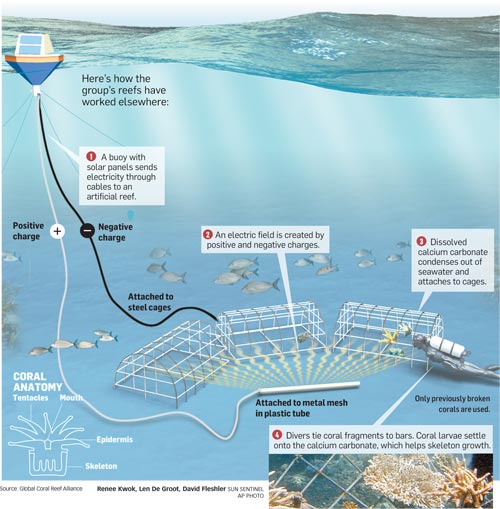Electricity and the Reef, A Shocking Way to Repair Coral Ecosystems PART 3
WARNING: Do not mix electricity and water. Doing so will lead to serious injury or death. The following article is in no way a recommendation to attempt the scientific endeavors described herein.
Is There More to it?

Obviously, there is more to electrochemical accretion than just making good rocks for corals to colonize. Most specimens studied not only anchor sooner and grow faster, they repair damage quickly and have higher survivability. The stability provided by rapid accretion certainly plays a role, but there is reason to believe the water chemistry near the cathode also enhances the corals metabolism.
As previously explained, the area near the cathode has a high pH and elevated alkalinity. In one study, scientist C.J. Zievis induced similar conditions using sodium bicarbonate, and demonstrated that knobby coral (Porites rus) grew better when so treated (2005). When scleractinian corals lay down new skeletal material, they actually do so externally to their own tissues. A thin compartment develops in between basal tissues and the aragonite skeleton. Within this pocket, aragonite is crystallized from extracytoplasmic calcifying fluid (ECF), which is highly concentrated with electrolytes. The confusing issue is whether the fluid is actively or passively created. That is, how much control does the coral exert over the composition of the ECF? Zievis showed that it is likely that both passive and active transport of electrolytes into the ECF occurs. His results also suggest that dissolved inorganic carbon might be a limiting factor for photosynthesis, and by extension growth.
The Zievis study substantiates the results of the accretionary experiments by providing a metabolic explanation for their findings. Others have postulated that the electrical field provides another metabolic benefit. The suggestion is that the electrical field adds bonus electrons to the process that creates ATP, the power-house molecule in cells. Coral and algal cells should therefore have extra energy to put into growth.
Conclusion
The evidence supporting electric reefs is growing and being corroborated by laboratory experiments. But there is no greater evidence than that provided by in situ reefs that have been constructed around the world in places like the Red Sea and the Caribbean. Though some coral are unsuitable for this type of propagation, for many species the benefit is clear. Better growth, higher survivability, and greater recovery are but a few of the good things this technology offers. For the first time in a long time, there is a reason to be optimistic about the long-term prospects of coral reef restoration. Naturally, there are limitations to what electrochemical accretion can achieve, but the upside is more than strong enough to justify continued use of this marvelous technological development.
Electrochemical accretion, and the subsequent environmental change it causes in seawater, is fascinating. Not only does it impact the physical environment, it impacts the metabolic environment inside the cells of living organisms. The technology gives us the ability to interact with the marine ecosystem in a far more profound way than previously believed possible. My research into this method of reef restoration has left me more than impressed with its potential. It also seems like there are probably a few more benefits that have yet to be explored, and I look forward to their arrival.

Works Cited:
Borell, E.M., S.B.C. Romatzki, and S.C.A Ferse. Differential Physiological Responses of Two Congeneric Scleractinian Corals to Mineral Accretion and An Electrical Field. Coral Reefs, Vol. 29. pp. 191-200. 2010.
Borneman, E.H. and J. Lowrie. Advances in Captive Husbandry and Propagation: an Easily Utilized Reef Replenishment Means from the Private Sector. Bulletin of Marine Science, 69:2. pp. 897-913. 2001.
Collins, T. What are Coral Reef Services Worth? $130,000 to $1.2 million per Hectare, per Year. Oct. 16, 2009. URL: < http://www.eurekalert.org/pub_releases/2009-10/d-... >
Delmendo, M. N. A Review of Artificial Reefs Development and Use of Fish Aggregating Devices (Fads) in the Asean Region. Symposium on Artificial Reefs for Management of Marine Resources. May, 1990.
Hilbertz, W. and T. Goreau. Third Generation Artificial Reefs. Ocean Realm Magazine. Oct. 1997. Accessed via Global Coral Reef Alliance Online. URL: < http://www.globalcoral.org/third_generation_artif... >
Hilbertz, W. and T. Goreau. United States Patent: Method of Enhancing the Growth of Aquatic Organisms, and Structures Created Thereby. U.S. Patent Number 5,543,043. Aug. 1996.
Hilbertz, W.H. The Electrodeposition of Minerals in Sea Water for the Construction And Maintenance of Artificial Reefs. Artificial Reefs: Proceedings Of A Conference Held September 13-15, 1979 In Daytona Beach, Florida. pp. 123-148. 1981.
M.G. Sabater and H.T. Yap. Growth and Survival of Coral Transplants with and without Electrochemical deposition of CaCO3. Journal of Experimental Marine Biology and Ecology, 272:2. pp. 131-146. 2002.
Precht, W.F. (editor). Coral Reef Restoration Handbook. CRC Press: Boca Raton. 2006.
Riggs, B., F. Perez, and T. Goreau. The Electric Reef. 2007. URL: < http://www.timespub.tc/2007/01/the-electric-reef/... >
Schuhmacher, H., P. van Treeck, M. Eisinger, and M. Paster. Transplantation of Coral Fragments from Ship Groundings on Electrochemically Formed Reef Structures. Proceedings 9th International Coral Reef Symposium, Bali, Indonesia, Vol. 2. October 2000.
Siboni, N., et al. Conditioning Film and Initial Biofilm Formation on Electrochemical CaCO3 Deposition on a Metallic Net in the Marine Environment. Biofouling, 25:7. pp. 675-683. Oct. 2009.
Silberberg, M.S. Chemistry; the Molecular Nature of Matter and Change, Third Edition. McGraw Hill: Boston. 2003.
Staff. Electrochemical Reef Construction (ERCON). University of Essen Institute for Ecology. 2004. URL: < http://www.uni-due.de/nomatec/themen_ercon_inhalt... >
Yap, H. T., R. M. Alvarez, H. M. Custodio III, and R. M. Dizon. Physiological and Ecological Aspects of Coral Transplantation. Journal of Experimental Marine Biology and Ecology, 229:1. pp. 69-84. 1998.
Yap, H.T. and M.G. Sabater. Long-term effects of induced mineral accretion on growth, survival and corallite properties of Porites cylindrica Dana. Journal of Experimental Marine Biology and Ecology, 311:2. pp. 355-374. 2004.
Zievis, C.J. Enhanced Growth of the Scleractinian Coral Porites rus Through Elevated Alkalinity. Master of Science Thesis, University of Maine. Dec. 2005.
Photo Credits:
Kwok, R., L.D. Groot, and D. Fleschler. Global Coral Reef Alliance. Sun Sentinel: AP. 2009.